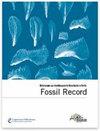下载PDF
{"title":"Globacrochordiceras gen. nov. (Acrochordiceratidae, late Early Triassic) and its significance for stress-induced evolutionary jumps in ammonoid lineages (cephalopods)","authors":"Claude Monnet, Hugo Bucher, Arnaud Brayard, James F. Jenks","doi":"10.1002/mmng.201300010","DOIUrl":null,"url":null,"abstract":"<p><i>Globacrochordiceras transpacificum</i> gen. et sp. nov. is an ammonoid (Ammonoidea, Cephalopoda) with a shell characterized by plicate ribbing (rounded and undulating ribs strengthening on the venter without interruption), increasing involution through ontogeny, overhanging and deep umbilical wall, absence of tuberculation, subtriangular whorl section, globose adult shape with a closed umbilicus followed by an abrupt egressive coiling, and a subammonitic adult suture line. This new taxon occurs in Nevada (USA) and in Guangxi (South China). It has its typical occurrence within the <i>Neopopanoceras haugi</i> Zone of late Spathian age (Early Triassic). The plicate ribbing, suture line and general shell shape are diagnostic of the family Acrochordiceratidae. The large adult size, high degree of involution and subammonitic suture line of <i>Globacrochordiceras</i> markedly contrast with the next younger genus of the family (<i>Paracrochordiceras</i> of early Anisian age, Middle Triassic), which is evolute and displays a ceratitic suture shape. Shell coiling and suture line of <i>Globacrochordiceras</i> are closer to that of the youngest member of the family: <i>Acrochordiceras carolinae</i> (late middle Anisian). The latter is the end-member of a long-term morphological evolutionary trend of the family during the early and middle Anisian. This trend composed of classical increases in adult size (Cope's rule), shell involution and suture indentation, lasted ca. four Myr. The sudden morphological evolutionary jump between <i>Globacrochordiceras</i> and <i>Paracrochordiceras</i> at the Spathian/Anisian (Early/Middle Triassic) boundary may correspond to a generalized morphological reset of long-term trends, a process that differs from classic paedomorphic transformations. A dramatic global sea level change and carbon isotope positive excursion at the Early/Middle Triassic boundary both indicate stressful environmental changes that may have triggered this evolutionary jump. (© 2013 WILEY-VCH Verlag GmbH & Co. KGaA, Weinheim)</p>","PeriodicalId":55147,"journal":{"name":"Fossil Record","volume":"16 2","pages":"197-215"},"PeriodicalIF":1.4000,"publicationDate":"2013-08-05","publicationTypes":"Journal Article","fieldsOfStudy":null,"isOpenAccess":false,"openAccessPdf":"https://sci-hub-pdf.com/10.1002/mmng.201300010","citationCount":"21","resultStr":null,"platform":"Semanticscholar","paperid":null,"PeriodicalName":"Fossil Record","FirstCategoryId":"89","ListUrlMain":"https://onlinelibrary.wiley.com/doi/10.1002/mmng.201300010","RegionNum":4,"RegionCategory":"地球科学","ArticlePicture":[],"TitleCN":null,"AbstractTextCN":null,"PMCID":null,"EPubDate":"","PubModel":"","JCR":"Q3","JCRName":"Earth and Planetary Sciences","Score":null,"Total":0}
引用次数: 21
引用
批量引用
Abstract
Globacrochordiceras transpacificum gen. et sp. nov. is an ammonoid (Ammonoidea, Cephalopoda) with a shell characterized by plicate ribbing (rounded and undulating ribs strengthening on the venter without interruption), increasing involution through ontogeny, overhanging and deep umbilical wall, absence of tuberculation, subtriangular whorl section, globose adult shape with a closed umbilicus followed by an abrupt egressive coiling, and a subammonitic adult suture line. This new taxon occurs in Nevada (USA) and in Guangxi (South China). It has its typical occurrence within the Neopopanoceras haugi Zone of late Spathian age (Early Triassic). The plicate ribbing, suture line and general shell shape are diagnostic of the family Acrochordiceratidae. The large adult size, high degree of involution and subammonitic suture line of Globacrochordiceras markedly contrast with the next younger genus of the family (Paracrochordiceras of early Anisian age, Middle Triassic), which is evolute and displays a ceratitic suture shape. Shell coiling and suture line of Globacrochordiceras are closer to that of the youngest member of the family: Acrochordiceras carolinae (late middle Anisian). The latter is the end-member of a long-term morphological evolutionary trend of the family during the early and middle Anisian. This trend composed of classical increases in adult size (Cope's rule), shell involution and suture indentation, lasted ca. four Myr. The sudden morphological evolutionary jump between Globacrochordiceras and Paracrochordiceras at the Spathian/Anisian (Early/Middle Triassic) boundary may correspond to a generalized morphological reset of long-term trends, a process that differs from classic paedomorphic transformations. A dramatic global sea level change and carbon isotope positive excursion at the Early/Middle Triassic boundary both indicate stressful environmental changes that may have triggered this evolutionary jump. (© 2013 WILEY-VCH Verlag GmbH & Co. KGaA, Weinheim)
Globacrochordiceras gen. 11 . (acrochordicerdae,晚早三叠世)及其在氨类(头足类)进化跳跃中的意义
Globacrochordiceras transspacificum gen. et sp. 11 .是一种氨鱼(氨鱼总目,头足纲),其壳的特点是有弯曲的肋(圆形和起伏的肋在腹内不间断地加强),在个体发育过程中逐渐内化,脐壁突出和深,无结节,近三角形的螺旋截面,球形成虫形状,封闭的脐部随后突然向外卷曲,以及亚氨水成虫缝合线。这个新分类群分布于美国内华达州和中国南部广西。其典型产状为晚Spathian(早三叠世)Neopopanoceras haugi带。重复的肋、缝合线和一般的壳形是桡足桡足虫科的诊断特征。Globacrochordiceras成虫体型大,对合程度高,缝合线呈亚氨质,与该科下一个较年轻的属(中三叠世早安尼期的Paracrochordiceras)形成鲜明对比,后者为演化型,呈角化缝合线状。Globacrochordiceras的壳卷曲和缝合线更接近于该家族最年轻的成员:Acrochordiceras carolinae(中安尼期晚期)。后者是该家族在早期和中期的长期形态进化趋势的末端成员。这一趋势由典型的成虫尺寸增大(柯普法则)、壳内翻和缝线压痕组成,持续约4 Myr。在Spathian/Anisian(早/中三叠世)边界,globacrochordicera和paracrochordicera之间的突然形态进化跳跃可能对应于长期趋势的广义形态重置,这一过程不同于经典的童形转变。全球海平面的剧烈变化和早/中三叠世边界的碳同位素正偏移都表明,压力的环境变化可能引发了这种进化跳跃。(©2013 WILEY-VCH Verlag GmbH &KGaA公司,Weinheim)
本文章由计算机程序翻译,如有差异,请以英文原文为准。


